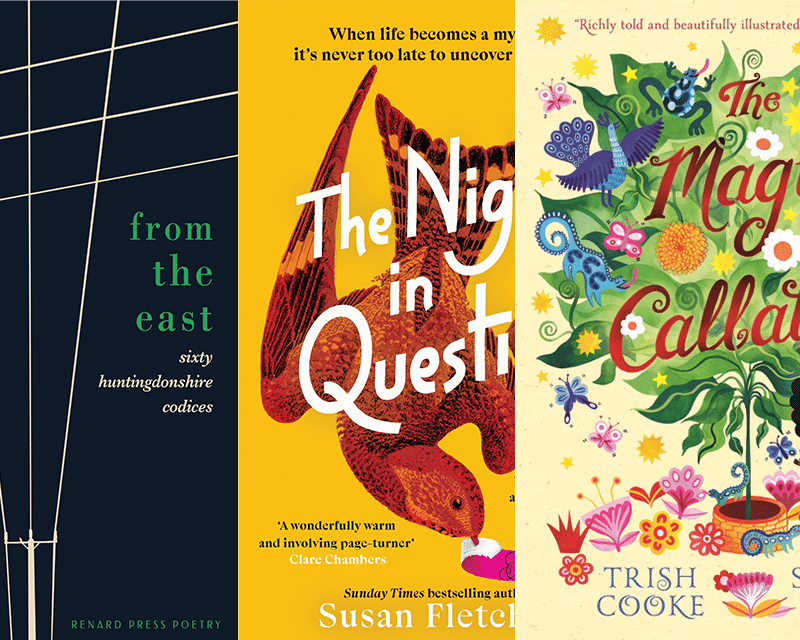- Collected
- Article
M.R. James and the Lost Treasure of Father Reinartz
A detective in search of a ghost story

- 19 December, 2016
- Helen Grant
My father used to entertain us on long car journeys by retelling the ghost stories of Montague Rhodes James. He had parts of them off by heart: the ‘flutterin’ rags and whity bones’ of the horrors in ‘Wailing Well’; the ‘horrible, an intensely horrible, face of crumpled linen’ that characterises the apparition in ‘Oh, Whistle, and I’ll Come to You, My Lad.’ These antique stories made a pleasurably dreadful impression. I can only compare the experience to watching Murnau’s 1922 film Nosferatu; although much more graphically horrifying films have been made since, there is something sinister in the very oldness of it, in the crackling and the fading and the sepia tones.
Years passed, and I periodically reread James’s ghost stories; they became old friends. In 2001, I and my family moved to the German Eifel, with its rolling hills and deep forests of pine and beech. Amongst the hundreds of well-thumbed paperbacks we took with us was a battered copy of The Collected Ghost Stories of M.R. James. I was preoccupied with things other than ghost stories at that time; our children were very young and we were struggling to manage in a foreign country.
Now and again I had to drive from our home in Bad Münstereifel to nearby Nettersheim. One winter afternoon as I followed that road I noticed in passing a sign towards Steinfeld. It seemed to me that the name was vaguely familiar. It was not until we had been living in Germany for several years that the penny dropped. I had seen it in M.R. James’s tale ‘The Treasure of Abbot Thomas’.
The story concerns an antiquary researching some stained-glass windows in a private chapel belonging to an English nobleman. This set-up had some distinctly autobiographical elements for M.R. James. Although best known nowadays for his ghost stories, he was in fact a highly regarded mediaevalist. In 1904 he was asked by Lord Brownlow, of Ashridge House in Hertfordshire, to catalogue the windows in the chapel. The glass had been imported a century before and little was known of its provenance. James correctly identified a large portion of it as coming from Steinfeld Abbey in Germany.
The experience inspired him to write ‘The Treasure of Abbot Thomas’. James’s fictional antiquary Mr Somerton also successfully traces some windows from Steinfeld Abbey. In doing this, he discovers a message concealed in them: a coded Latin inscription hidden under a coat of black paint. Realising that it describes the location of treasure hidden at Steinfeld, he sets off to find it, but runs up against the terrifying supernatural guardian of the horde.
The story is one of James’s best. It is bursting with convincing-sounding antiquarian detail – James went so far as to incorporate a quotation in Latin, supposedly from an eighteenth-century history of Steinfeld Abbey, complete with learned footnotes – and has a wonderfully repulsive monster. Now here I was, living a mere twelve miles away from the abbey where the story was set!
And so it was down the rabbit hole. I could not be happy until I had been to Steinfeld Abbey, and having been to Steinfeld Abbey, I stumbled into a labyrinth of other paths requiring investigation.
The road to Steinfeld winds uphill through open countryside. The first things you glimpse are the blue slate spire of the abbey church, and the twin towers at its west end. A high wall surrounds the abbey grounds; within is a cluster of buildings surrounding the ancient cloister that originally housed the sixteenth-century stained glass that M.R. James saw at Ashridge. As in ‘The Treasure of Abbot Thomas’, the glass was sold when the abbey closed in 1802, and simply vanished. The abbey itself remained closed until it was taken over by another order in 1923. Meanwhile, the glass was presumed to have been destroyed — until M.R. James identified it at Ashridge.
Although the windows inspired his story, James himself never visited Steinfeld; the scenes set there are the product of his imagination. Nor, seemingly, did it occur to him to notify anyone at Steinfeld of his discovery. Perhaps, given that the Abbey community had been dissolved a century before, it did not seem likely that there was anyone to inform. And yet in this quiet corner of Germany there was someone ready to take a keen interest in the fate of the long lost glass. But it was not as a result of James’s scholarly work that his discovery was eventually made known to Steinfeld’s friends; it was due to ‘The Treasure of Abbot Thomas’.
I found the first clue to this fascinating story in a small display about M.R. James in a corner of the cloister. It briefly mentioned the fact that a local historian and priest, Nikola Reinartz, had contacted James after reading a news item about James’s short story. Father Reinartz had subsequently written several articles about the Steinfeld glass. This was simply too tempting; I obtained copies of the articles, which were published in two local periodicals, both printed in the eye-watering Gothic typeface that was common in Germany at the time.
It was worth the (considerable) effort. Here was a first-hand account of how word had reached Steinfeld of the fate of the lost glass. It was also a tale dependent on some remarkably tenuous connections. Reinartz related how he had stumbled across a 1907 article in which a Dr. Förster remarked that ‘The Englishman M.R.James from Cambridge tells a ghost story from Steinfeld in his agreeably written book Ghost Stories of an Antiquary.’ Dr. Förster noted that James had correctly located Steinfeld in the Eifel and not the Ardennes as had sometimes erroneously been done, but that was all he said. The stained glass was not mentioned.
Nevertheless, this scanty scrap of information was enough to pique Reinartz’s interest. I suspect one of the reasons I came to feel such an affection for him was that clearly, like me, he was prey to these little obsessions, this inability to prevent himself being drawn further and further into them. What did this Englishman know of a treasure of Abbot Thomas? How on earth had he come across Steinfeld? Reinartz described himself as being ‘continually dogged’ by these questions. When, in 1908, he had an opportunity to visit London for an ecclesiastical conference, he decided to try to obtain a copy of James’s book to satisfy his curiosity.
At a bookseller’s on the Charing Cross Road, he asked for a copy of Ghost Stories of an Antiquary, but the bookseller didn’t know whether they had it amongst their chaotically stacked stock. Just as Reinartz was about to leave, he looked down and saw that he had inadvertently rested his hand on a copy of it. He bought the book, and devoured the story. It raised more questions than it answered, and Reinartz was unable to leave it there; instead, he wrote to James at Cambridge, asking for more information.
James replied explaining that some of the things mentioned in the story were fictional but that he really had seen the Steinfeld glass at Ashridge Park. Reinartz promptly wrote to the estate management at Ashridge and asked if he could have a look at it. For some reason, they turned him down — but he was not a man to give up. He wrote to James again and obtained a letter of reference; this time he simply showed up at the gates of Ashridge Park and presented the staff with the letter. He was allowed inside.
In his article of 1909 he described the sense of wonder he felt, the way his heart thumped as he picked out names and figures from his homeland. At the same time, he felt a terrible sadness at the way the panes had been mixed up and hacked about to fit them into the windows at Ashridge; a ‘glittering ruin’, he called them. It was something, however, to be the first person associated with Steinfeld in a century to set eyes upon its magnificent stained glass. And all of this came about because of a couple of lines in an obscure local journal, and his own persistence.
I have several photographs of Father Reinartz, copies of originals in the archive at Euskirchen. My favourite, probably taken in 1932, shows him in middle age, clad in bowler hat, a rather natty coat and boots, and carrying a walking stick, his expression good-humoured but unsmiling. He outlived M.R. James by eighteen years and, unlike James, lived through the Second World War. He was an outspoken opponent of Nazism, in spite of repeated harassment by the Gestapo. He died in 1954, at the age of 79 and was buried in the churchyard at Kreuzweingarten, some twenty miles from Steinfeld.
In April 2010 I visited his grave by the south wall of the church, and planted some forget-me-nots there. I wanted to pay my respects to someone I had come to admire — a man who seized the tiny clue that chance threw in his way, and pursued it until he found his own treasure.
I have also been to see the Steinfeld glass. It was never returned; it was auctioned at Sotheby’s in the 1920s and is now in the Victoria and Albert Museum. Whenever I see it, I share some of Reinartz’s mixed feelings. Only a few of the windows are on display, and in the corner of a room whose plain walls do little to recall the ancient stone tracery that originally framed the glass. In spite of this, the beauty of the work is still evident in the vivid colours, the dynamic composition of the figures and the rich detail. I feel, with Father Reinartz, the poignancy of it being so far from home, but at the same time I marvel at the miracle of its survival.
So much of the writer’s imagination is taken up with ‘what if…?’ We delight in improbable choices, the tenuous chain of events that leads to a dramatic situation or startling discovery. We are aware of the multiverse of possibilities that springs from every tiny moment of decision. The history of the Steinfeld glass is a story about those tenuous links — about things that very nearly didn’t happen.
You might also like:
No facts, only versions
Memoirs are as much about what is excluded as what is included. This edition examines how you can evoke the…
RLF Fellows’ News: April 2024
Publishing News RLF Fellow Trish Cooke’s new children’s book, The Magic Callaloo, is set to be published by Walker Books…
Susan Fletcher on outsiders in fiction – literal and imagined
I’ve always known that I’ve preferred to be outside. To be an outsider – literally, and, specifically, amongst wild places…


